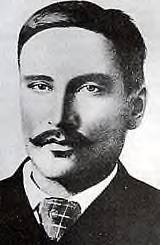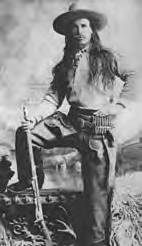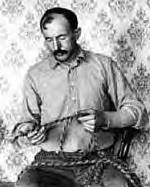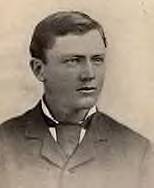Pleasant Valley War - Wikipedia
| The Pleasant Valley War, sometimes called the Tonto Basin
Feud, or Tonto Basin War, was commonly thought to be an Arizona sheep war
between two feuding families, the cattle-herding Grahams and the sheep-herding
Tewksburys. However, eyewitness reports show that sheep were not brought
into Pleasant Valley until 1885, two years after the feuding between the
Tewksbury and Graham factions began. Although Pleasant Valley is physically
located in Gila County, Arizona, many of the events in the feud took place
in Apache County, and in Navajo County. The feud itself lasted for about
a decade, with its most deadly incidents between 1886 and 1887, with the
last known killing occurring in 1892. Of all the feuds that have taken
place throughout American history, the Pleasant Valley War was the most
costly, resulting in an almost complete annihilation of the two families
involved.
1882 - 1885
Origin
During the late 1880s, a number of range wars—informal
undeclared violent conflicts—erupted between cattlemen and sheepmen over
water rights, grazing rights, or property and border disagreements. In
this case, there had been quarrels between the workhands of both factions
as far back as 1882. The early clashes stemmed from accusations of cattle
and horse rustling leveled at both parties, and some both the Tewksbury's
and Grahams were arrested on charges made by another rancher, Jim Stinson,
that they all had taken part in rustling cattle from Stinson's ranch.
There is also an undercurrent of racial prejudice against
the Tewksburys who were half-Indian, and therefore referred to as "damn
blacks" by the Grahams and Stinson. Stinson made a deal with the Grahams
to pay them each fifty head of cattle and see that they never served jail
time if they would turn state's evidence against the Tewksbury brothers.
The Grahams took the deal and went to work for Stinson with the expressed
vow to drive them out of Pleasant Valley. The case against the Tewksbury's
was thrown out of court for lack of evidence.
The notion that this was a sheep v. cattle range war came
about in part because the first killing in the feud was the murder of a
Basque sheep herder who worked for the Daggs Brothers sheep ranch in northern
Arizona. In 1885, the Tewksbury brothers leased some sheep from Daggs,
and they sent the sheep to Pleasant Valley with the Basque sheep herder.
The Basque sheep herder was murdered and robbed by Andy Cooper who was
one of the Graham faction. Overall, between twenty to thirty-four deaths
resulted directly from the feud.
Once partisan feelings became tense and hostilities began,
Frederick Russell Burnham was drawn into the conflict in 1884. Initially
he was not involved but was dragged into it and subsequently marked for
death. Burnham hid for many days before he could escape from the valley.
With the help of friends, he managed to get out of the feud district after
several months during which he had a number of narrow escapes, accounts
he recalls in his memoirs, Scouting on Two Continents.
|

Edwin Tewksbury in the
1890s, the last surviving
Tewksbury ho was involved
in the feud.
. |

Commodore Perry Owens as
the sheriff of
Apache County, Arizona
in 1886. |

A rare image of Tom Horn examining a lasso. |

Frederick Russell Burnham in Arizona Territory during
1881. |
Date 1882 - 1892
Location Tonto Basin, Arizona Territory
Belligerents
Graham family
Blevins Family
Tewksbury Family
Casualties - 20 - 34 killed |
The Wells Outfit
A local cattleman, Fred Wells had borrowed a lot of money
in Globe, Arizona to build back his cattle herd. The Wells clan had no
stake in the feud, but his creditors did. Wells was told to join their
forces in driving off the opposition's cattle or forfeit his own stock.
When Wells refused, his creditors demanded immediate payment of the loans
and sent two deputies to attach his cattle. Wells gathered his clan and
cattle together along with a young ranch hand named Frederick Russell Burnham,
who Wells had trained in shooting and considered him almost a part of his
family, and began driving his herd into the mountains, hotly pursued by
the deputies.
It was slow going to drive the cattle into the mountains
and the deputies had no trouble overtaking the Wells clan. The deputies
forced the girls and the mother to halt which then set off the barking
dogs. Burnham and John Wells, the son of Fred Wells and Burnham's close
friend, rushed back. Just when they arrived one of the dogs bit a deputy
as he was dismounting. The deputy drew and shot the dog, which then caused
Burnham, John, and two of the girls to also draw their weapons. The dismounted
deputy then fell dead, shot from a long distance by Fred Wells, and the
other deputy raised his hands. The clan continued into the mountains with
the captured deputy and then released him once their objectives were secure.
The deputy returned to Globe and reported on the incident.
In Globe, a meeting was held to discuss the elimination
of Fred and John Wells, and an "unknown gunman carrying a Remington six-shoot
belt", that is, Burnham and his Remington Model 1875 sidearm and bandolier.
Private posses were raised for raiding the opposition. Killings and counter-killings
became a weekly occurrence. For the Wells outfit it became a sheer waste
of human life in a struggle without honor or profit in another man's feud,
and seemingly without end.
Frederick Russell Burnham Escapes
For Burnham, it became apparent that he had the worst
of two worlds. His faction was losing and every man he killed created a
new feud, a personal one, not winner take all, but winner take on all.
Only nineteen years old and facing a grim future as a nameless gunslinger
whose only "crime" had been to stand by his friends the Wells, Burnham
went to Globe and looked up another friend, the editor of the Silver Belt
newspaper. On his way to Globe he was nearly killed by George Dixon, a
well-known bounty hunter and cattle rustler who found Burnham hiding in
a cave. Dixon held a Colt .45 to Burnham's head and was ordering him outside
when someone outside the cave shot and killed Dixon. A White Mountain Apache
nicknamed Coyotero had been tracking Dixon and he shot the bounty hunter
through the heart just as he was capturing Burnham. Burnham immediately
grabbed his Remington, moved behind a ledge, and shot Coyotero dead.
Once in Globe, Burnham contacted his friend, the Silver
Belt editor, and stayed hidden in his house. With this man's help, Burnham
assumed several aliases and made the difficult journey out of the Basin.
He eventually arrived in Tombstone, Arizona, and stayed with friends of
the Silver Belt editor. Once in Tombstone, he began to reflect on the feud:
"Now my mind began to clarify. I saw that my sentimental siding with the
young herder's cause [Ed note: John Wells] was all wrong; that avenging
only led to more vengeance and to even greater injustice than that suffered
through the often unjustly administered laws of the land. I realized that
I was in the wrong and had been for a long time, without knowing it. That
was why I had suffered so in the Pinal Mountains."
1886 - 1887
In February, 1887 a Navajo employee of the Tewksburys
was herding sheep in an area called the Mogollon Rim, which until that
point had been tacitly accepted as the line across which sheep were not
permitted. He was ambushed, shot and killed by Tom Graham, who buried him
where he fell.
Shootout at Tewksbury's Ranch
In September, 1887, a grisly incident occurred which has
been the basis of many stories about the feud and which sparked a deadly
chain of events. The Graham faction surrounded a Tewksbury cabin in the
early morning hours and coolly shot down John Tewksbury and William Jacobs
as they started out for horses.
The Grahams continued firing at the cabin for hours, with
fire returned from within. As the battle continued, a drove of hogs began
devouring the bodies of Tewksbury and Jacobs. Although the Grahams did
not offer a truce, John Tewksbury's wife came out of the cabin with a shovel.
The firing stopped while she scooped out shallow graves for her husband
and his companion. Firing on both sides resumed once she was back inside,
but no further deaths occurred that day, and after a few hours the Grahams
rode away. "His wife denied this happened. The firing actually stopped
because the gunmen heard a sheriffs posse headed toward the location. In
truth it took four men most of the rest of the day to bury the bodies of
the deceased about a foot down because the ground was so hard. They covered
the bodies with a sheet and then piled rocks over them to keep wild animals
from eating what was left of the bodies".
Owens-Blevins Shootout
A few days later, Andy Cooper, or Andy Blevins, one of
the leaders of the Graham faction, was overheard in a store in Holbrook,
Arizona bragging that he had shot and killed both John Tewksbury and William
Jacobs. The sheriff for Apache County, Commodore Perry Owens, was a noted
gunman, and had a warrant for Blevins' arrest on an unrelated charge. Owens
rode alone to the Blevins house in Holbrook to serve the warrant.
Twelve members of the Blevins family were present at the
house that day. Owens stated that he had an outstanding warrant for Andy
Blevins and asked him to come out of the house. Blevins refused. His half-brother,
John Blevins, then came out the front door and fired a shot at Owens with
a rifle. Owens returned fire, wounding John and killing Andy. A friend
of the family named Mose Roberts who was in a back room, jumped up and
through a window at the side of the house.
Owens, hearing the noise, ran to the side of the house
and fired on the man, killing him. It is disputed as to whether Roberts
was armed or not. Some reports indicate he was armed with a rifle, others
alleged that he was unarmed. It has also been alleged that he only leaped
through the window to avoid bullets that passed into his room. At that
moment, fifteen-year-old Sam Houston Blevins then ran outside, armed with
a pistol he had picked up off the floor next to the body of his brother
Andy. With his mothers arms around him trying to hold him back, Owens shot
and killed him, as the boy fired on Owens.
The whole incident took less than one minute but resulted
in three dead and one wounded. Despite the shots fired at him, Owens was
not injured. The afternoon made Owens a legend, but only added fuel to
the fire of the feud. Owens was not indicted, and the shooting was ruled
self defense without any trial. He was dismissed by the County Commission
over the incident, mostly due to the boy being killed, regardless of the
fact that the boy himself was armed.
Shootout at Perkins Store
In September 1887, Sheriff Mulvernon of Prescott, Arizona
led a posse that pursued and killed John Graham and Charles Blevins during
a shootout at Perkins Store in Young, Arizona.
Involvement of Tom Horn
It was most likely during this stage that outsider and
known assassin Tom Horn participated, possibly as a killer for hire, but
it is unknown which side employed him, and both sides suffered several
murders to which no suspect was ever identified. In his autobiography,
however, Horn writes: "Early in April of 1887, some of the boys came down
from the Pleasant Valley, where there was a big rustler war going on and
the rustlers were getting the best of the game." Horn says he was tired
of working his mining claim and therefore was "willing to go, and so away
we went." He then claims that he "became the mediator" of the conflict,
serving as a deputy sheriff under three famous Arizona lawmen of the time:
William Owen “Buckey” O’Neill, Commodore Perry Owens, and Glenn Reynolds.
1888 - 1892
Over the next few years after 1887, several lynchings
and unsolved murders of members of both factions took place, often committed
by masked men. Both the Tewksburys and the Grahams continued fighting,
until there were only two left.
In 1892, Tom Graham, the last of the Graham faction involved
in the feud, was murdered in Tempe, Arizona. Edwin Tewksbury, the last
of that faction involved in the feud, was accused of the murder. Defended
by well-known Arizona attorney Thomas Fitch, the first trial ended in a
mistrial due to a legal technicality.
The jury in the second trial dead-locked seven to five
for acquittal. Edwin Tewksbury died in Globe, Arizona in April, 1904. By
the time of his release, none of the Grahams remained to retaliate against
him, nor was there anyone on the Tewksbury side to have avenged his death
had anyone killed him.
Cultural references
A documentary by film maker Michael Bast was created
for television. "Forgotten Gunfighters: The Pleasant Valley War". http://michaeldbast.com/my-documentary-about-the-pleasant-valley-war/
Well-known Westerns author Zane Grey wrote a book entitled
To The Last Man: A Story of the Pleasant Valley War; although, in this
novel the two main participating family factions were known as Isbel and
Jorth.
The 1992 television movie, Gunsmoke: To the Last Man involves
Matt Dillon, hero of the television series Gunsmoke, in the Pleasant Valley
War.
Each year on the third weekend in July, Pleasant Valley,
Arizona (since renamed Young) celebrates Pleasant Valley Days with a parade
and tours of the cabins and battle sites of the Pleasant Valley War. The
graves of many of the men killed during the feud can be seen today in the
local cemetery.
"DRAG-A-LONG DROOPY" (1952), a comic, animated cartoon
depicting the cattle-sheep range wars.
49 minutes Documentary,
"The Pleasant Valley War"
|